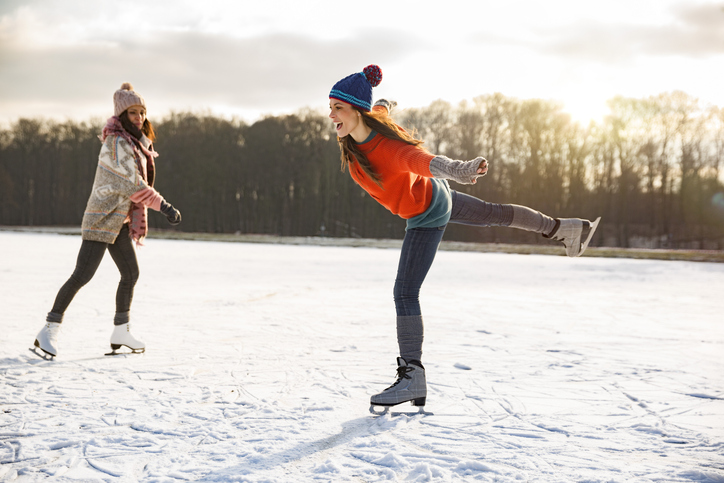Starting out in ice skating is both exciting and a bit challenging, but with the right techniques, you can quickly build confidence on the ice. This guide covers ten essential tips to help beginners get started smoothly. From finding your balance to making your first glides, these tips are designed to make your experience fun and safe. Whether you’re aiming to skate for fun or want to work toward more advanced skills, these basics are the best place to start.
1. Choose the Right Skates
The first step to a comfortable and enjoyable experience is picking the right pair of skates. For beginners, renting skates at the rink is often convenient, but be sure they fit snugly and offer good ankle support. If your skates are too loose, you’ll struggle to stay balanced; if they’re too tight, they’ll be uncomfortable. As you progress, you may want to invest in your own skates suited for your preferred skating style.

2. Dress in Layers for Comfort
Ice rinks can be chilly, so dressing in layers is a good idea. Wear flexible, warm clothing like leggings, sweatpants, or athletic pants, and a light jacket that allows movement. Avoid bulky clothes, as they can limit flexibility, and don’t forget gloves or mittens—they keep your hands warm and offer some protection if you fall.
3. Warm Up and Stretch
Skating is physical, so warming up and stretching beforehand will prepare your muscles and reduce the risk of strains. Stretch your legs, especially your calves, quads, and ankles, to prepare them for movement. Even a quick warm-up, like a few squats or lunges, will help get your body ready for the ice.
4. Practice the Right Stance
Balance is the foundation of ice skating, and having the right stance is essential. Stand with your feet hip-width apart, bend your knees slightly, and lean slightly forward. Keep your weight centered over the middle of your skates, not on your heels or toes. This stance keeps you stable and gives you better control as you start moving.
5. Start with Small Steps
When you’re first on the ice, start with small, shuffling steps instead of trying to glide. Think of it as a walking motion that gradually builds your confidence and control. As you get more comfortable, you can begin extending your pushes and transitioning into a smoother glide. This slow start helps you get used to the feel of the ice beneath you.
6. Learn How to Fall Safely
Falling is a normal part of learning to skate, so knowing how to fall safely can help prevent injuries. If you feel yourself losing balance, try to fall to the side or forward, as falling backward can lead to wrist or tailbone injuries. When you’re ready to get up, roll to your hands and knees, then place one foot on the ice and use your hands to push yourself up. Practicing this off the ice can make it easier to handle on the rink.
7. Practice Gliding on Both Feet
Once you feel stable on the ice, work on gliding. Begin by gently pushing off with one foot and bringing your feet together to glide forward. Hold the position for a few seconds, focusing on your balance and posture. Gliding on two feet is a basic move that helps you get comfortable with the feeling of moving smoothly on the ice.

8. Learn Basic Stopping Techniques
Knowing how to stop is crucial for controlling your movement and staying safe on the ice. The snowplow stop is one of the simplest methods for beginners. To perform a snowplow stop, bend your knees slightly, point your toes inward, and gently push your heels outward to form a “V” shape. This will help slow you down gradually. Practice stopping regularly to build confidence and control.
9. Focus on Staying Relaxed
Many beginners feel nervous and tense, but staying relaxed will make skating much easier. Avoid stiffening your body; keep your arms out for balance, your knees slightly bent, and let your body adjust naturally to the movement. Staying relaxed helps you respond to shifts in movement more fluidly, making it easier to balance.
10. Practice Regularly and Have Patience
Like any skill, ice skating improves with practice. Every session on the ice builds your confidence, balance, and control. Don’t rush the process; focus on gradual improvements and set small goals, such as practicing stopping, balancing, or gliding. Celebrate each little success, and remember that progress takes time.
Additional Tips for Beginner Skaters
Once you’ve got the basics down, you can try new moves like turning, backward skating, or simple spins to build on your skills. Each new skill you learn helps to strengthen your balance and control, making it easier to try more advanced techniques. Above all, remember that every skater starts as a beginner, so enjoy each step of the journey.
Conclusion
Ice skating is a rewarding activity that combines balance, coordination, and fun. By focusing on these ten beginner tips, you’ll build a solid foundation for enjoying your time on the ice. With patience and practice, each skating session will bring you closer to mastering the basics and feeling more confident. So lace up those skates, stay focused on balance, and most importantly, have fun as you learn and glide!

